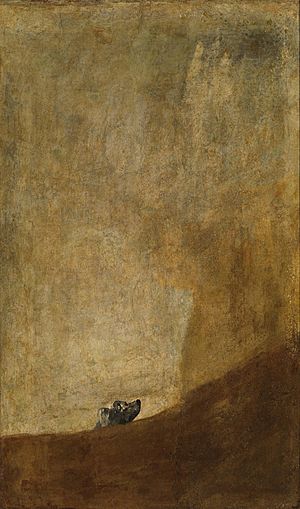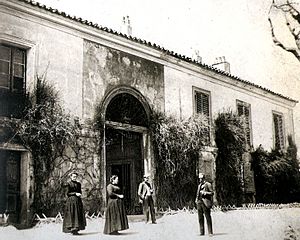The Dog (Goya) facts for kids
Quick facts for kids The Dog |
|
|---|---|
 |
|
| Artist | Francisco Goya |
| Year | circa 1819–1823 |
| Type | Oil mural on plaster transferred to canvas |
| Dimensions | 131.5 cm × 79.3 cm (51+3⁄4 in × 31+1⁄4 in) |
| Location | Museo del Prado, Madrid |
The Dog (Spanish: El Perro) is a famous painting by the Spanish artist Francisco Goya. You can see it today in the Museo del Prado in Madrid, Spain. The painting shows just the head of a dog looking up. The dog seems very small in a huge, empty space. Below the dog, there's a dark, sloping area that hides its body. Many people feel the dog looks like it's in trouble or even drowning.
The Dog is part of a special group of paintings called Goya's Black Paintings. Goya painted these directly onto the walls of his house, called Quinta del Sordo, between 1819 and 1823. He was in his 70s then and was going through a difficult time. He never planned for these paintings to be seen by others. They stayed hidden in his house for about 50 years after he left.
Contents
Goya's Home and His Art
In 1819, Goya bought a house near Madrid called "Quinta del Sordo". This means "Villa of the Deaf Man." The house got its name from a previous owner who was deaf. Goya himself was also deaf because of an illness he had in 1792.
Between 1819 and 1823, Goya created 14 artworks right on the walls of his house. He used oil paints for these works.
Why Goya Painted the Black Paintings
Goya was 73 years old and had been very sick twice. He was likely thinking a lot about life and death. He was also upset by the many conflicts and civil unrest happening in Spain. During this time, he was also working on his series of prints called The Disasters of War.
At first, Goya decorated his house with brighter pictures. But over time, he painted over them with the intense and sometimes scary images we now call the Black Paintings. He didn't get paid to paint these, and they were never meant for public display. These pictures show his sad and troubled feelings, with scenes of darkness, struggle, and hopelessness.
Goya never gave titles to these paintings. The names we use today were given by others after he died. So, The Dog is also known by names like A Dog, Head of a Dog, The Buried Dog, or The Half-Drowned Dog. In Spanish, it's often called El Perro or Perro Semihundido.
What the Painting Shows
The painting is split into two main parts. The top part is a large, dirty ochre (yellow-brown) "sky." The bottom part is a smaller, dark brown section that slopes up and turns black. The dog's head is seen just above this dark lower part. Its nose is lifted, its ears are back, and its eyes are looking up and to the right.
There's a faint dark shape above the dog. Some people think this is damage to the painting. Others believe it's a leftover mark from an earlier painting that Goya covered up.
Meanings Behind The Dog
The mysterious way Goya painted the dog has led to many different ideas about what he meant.
- Struggle and Hopelessness: Many see the painting as a symbol of how humans struggle against powerful, bad forces. The black sloping mass around the dog is often imagined as quicksand or earth where the dog is stuck. After trying to get free, the dog can only look up, hoping for help that might never come. The huge "sky" above makes the dog's loneliness and desperate situation feel even stronger.
- Fear or Abandonment: Other people think the dog is carefully lifting its head above the dark mass, perhaps afraid of something outside the painting. It could also show feelings of being left alone, forgotten, and sad. Art expert Robert Hughes once said, "We do not know what it means, but its pathos moves us on a level below narrative."
How Goya's Art Influenced Others
Goya's painting of the dog inspired other artists. For example, you can see his influence in the dog in Pierre Bonnard's 1910 painting, The Red-Checkered Tablecloth. However, Bonnard's painting is cheerful and clear, which is very different from Goya's deep and mysterious artwork.
Moving the Paintings from the Walls
Goya never meant for his Black Paintings to be seen by the public. But today, they are considered some of his most important works. When Goya left Spain for France in 1823, he gave the Quinta del Sordo house to his grandson, Mariano.
After the house changed owners several times, a French banker named Baron Émile d'Erlanger bought it in 1874. After about 70 years on the walls of the Quinta del Sordo, the paintings were starting to get damaged. To save them, the new owner had them carefully moved from the plaster walls onto canvas. This difficult job was led by Salvador Martínez Cubells, who was a curator at the Museo del Prado.
After showing the paintings at a big art show in Paris in 1878, d'Erlanger eventually gave them to the Spanish government. Over time, the paintings had suffered some damage. The tricky process of moving them from the crumbling plaster to canvas also caused some harm, and some small details might have been lost. Luckily, The Dog seems to have survived quite well. The faint dark shape in the upper right of the picture is sometimes thought to be damage from this process.
See also
- List of works by Francisco Goya
 In Spanish: Perro semihundido para niños
In Spanish: Perro semihundido para niños


